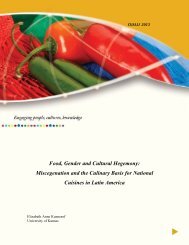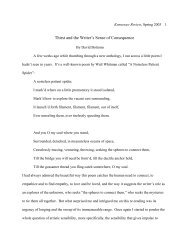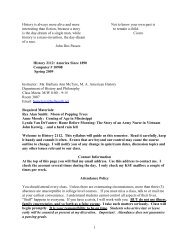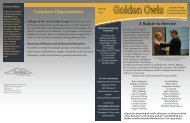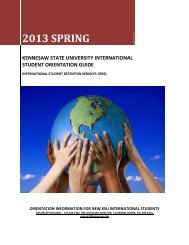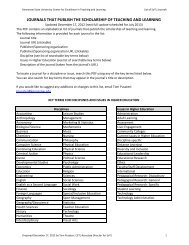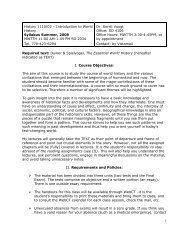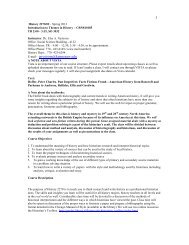LISTING OF GENERAL & SPECIFIC - Kennesaw State University
LISTING OF GENERAL & SPECIFIC - Kennesaw State University
LISTING OF GENERAL & SPECIFIC - Kennesaw State University
You also want an ePaper? Increase the reach of your titles
YUMPU automatically turns print PDFs into web optimized ePapers that Google loves.
1<br />
ASSURANCE <strong>OF</strong> LEARNING REVIEW 2005-2006<br />
KSU ASSURANCE <strong>OF</strong> LEARNING COUNCIL’S FORMATIVE FEEDBACK<br />
FOR THE __________BIOLOGY______ PROGRAM<br />
SECTION I- ARTICULATING STUDENT LEARNING OUTCOMES (FOR BASIC AND<br />
ADVANCED PROGRAM PLANS)<br />
INDICATORS (Use the Indicators Below as Needed to Provide Brief Summary Observations):<br />
• Knowledge/Skill/Attitude Balance and Student-Centered<br />
• SLO Differentiation<br />
• Compliance with Disciplinary Conventions<br />
• Building Upon Prior Learning<br />
• Lower-Order and Higher-Order Thinking<br />
Council’s Summary Observations:<br />
There are 3 GLOs, 17 associated SLOs and each SLO is described in detail with a good mix of<br />
Skills, Knowledge and Attitude.<br />
The report does not contain a matrix that shows a correlation of Biology with GenEd courses.<br />
Good verbal description of relationship to GenEd GLOs.<br />
The progression from lower-order to higher-order thinking is clear.<br />
The table on pages 2-7 is slightly confusing – perhaps a matrix with courses on one axis and<br />
SLO’s on the other, etc.
2<br />
SECTION II- CONNECTING OUTCOMES TO THE COURSE & PROGRAM<br />
REQUIREMENTS (FOR ADVANCED PROGRAM PLANS ONLY)<br />
INDICATORS FOR UNDERGRADUATE AND GRADUATE PROGRAMS (Use the<br />
Indicators Below as Needed to Provide Brief Summary Observations):<br />
• Linkage of All Program Requirements to SLOs<br />
• Reinforcing SLO Attainment through Multiple Program Requirements<br />
• Lower Division, Program Admission, & Prerequisite Requirements<br />
• Core Upper Division (or Graduate) Course Requirements<br />
• Elective Upper Division (or Graduate) Requirements of the Program<br />
• Building Upon General Education (or the Baccalaureate Education) Outcomes<br />
• Required Practicums & Internships<br />
• Capstone Experience<br />
INDICATORS FOR THE <strong>GENERAL</strong> EDUCATION PROGRAM (Use the Indicators Below as<br />
Needed to Provide Brief Summary Observations) :<br />
• Linkage of All Program Requirements to SLOs<br />
• Reinforcing SLO Attainment through Multiple Program Requirements<br />
• Building on the Precollege Experience<br />
• General Education Area A Course Requirements of the Program<br />
• General Education Area B Course Requirements of the Program<br />
• General Education Area C Course Requirements of the Program<br />
• General Education Area D Course Requirements of the Program<br />
• General Education Area E Course Requirements of the Program<br />
• Providing a Foundation for Upper Division Degree Programs<br />
Council’s Summary Observations:<br />
The program lacks a common capstone course or exit exam, hence, assessment efforts are focused<br />
on the last common courses taken by Biology majors - BIOL 3300 (Genetics) and BIOL 3380<br />
(Evolution).<br />
IIE; Not clear which SLO is being referred to
3<br />
SECTION III- CONNECTING OUTCOMES TO METHODS THAT COLLECT EVIDENCE <strong>OF</strong><br />
ASSURANCE <strong>OF</strong> LEARNING (FOR BASIC AND ADVANCED PLANS)<br />
INDICATORS (Use the Indicators Below as Needed to Provide Brief Summary Observations):<br />
• Focus of the Methods that Collect Evidence of Assurance of Learning for Assessing<br />
Students’ Knowledge, Skills, and Attitudes<br />
• Focus of the Methods that Collect Evidence of Assurance of Learning for Assessing<br />
Students’ Lower-Level and Higher-Level Thinking<br />
• Use of Reliable and Valid Methods that Collect Evidence of Assurance of Learning<br />
• Student Motivation Concerning the Methods that Collect Evidence of Assurance of<br />
Learning<br />
• Use of Multiple Measures<br />
• Use of Direct and Indirect Measures of Outcomes<br />
• Use of Quantitative and Qualitative Measures<br />
Council’s Summary Observations:<br />
General SLO should read GLO # 2<br />
Specific SLOs (1) should read SLO # 1<br />
Specific SLOs(2) should read SLO # 6<br />
Clearly stated evaluation methods:<br />
a. questionnaire for graduating seniors<br />
b. 100 multiple-choice exam questions will be embedded within the course<br />
c. Two embedded course assignments (e.g., lab reports) will be evaluated for 20% of the<br />
students in the course, selected at random.<br />
Rubric is being developed .<br />
Nothing is standardized
4<br />
SECTION IV- ARTICULATING EXPECTED AND HYPOTHESIZED FINDINGS FOR THE<br />
EVIDENCE (FOR ADVANCED PLANS)<br />
INDICATORS (Use the Indicators Below as Needed to Provide Brief Summary Observations):<br />
• Articulating Expected Findings for each Method that Collects Evidence of Assurance of<br />
Learning<br />
• Use of Measurable/Observable Language<br />
• Use of an Appropriate Standard<br />
• Clarity of the Expected Findings<br />
Council’s Summary Observations:<br />
The department is considering various alternatives including standardized tests as a means for<br />
assessing their learning outcomes.<br />
This appears to be a work in progress.
5<br />
SECTION V- ARTICULATING THE PLAN AND TIMETABLE FOR COLLECTING<br />
EVIDENCE <strong>OF</strong> ASSURANCE <strong>OF</strong> LEARNING (FOR BASIC AND ADVANCED PLANS)<br />
INDICATORS (Use the Indicators Below as Needed to Provide Brief Summary Observations):<br />
• Completeness of the Evidence Gathering Plan<br />
• Strengths and Weaknesses of the Evidence Gathering Plan<br />
• Practicality of the Evidence Gathering Plan<br />
Council’s Summary Observations:<br />
Time table clearly stated out to year 2009:<br />
BIOL 300 (Genetics) and BIOL 3380 (Evolution) will be assessed in alternating years beginning<br />
in fall 2005. The graduate exit survey was developed and pilot-tested in spring 2005, and fully<br />
implemented in fall 2005.<br />
In fall 2007 (the second evaluation of BIOL 3300) assessment of the specific learning outcomes in<br />
GLO#1 will be incorporated, and in fall 2009(the third evaluation of BIOL 3300) the specific<br />
learning outcomes in GLO #3 will be included. \<br />
Will have an AOL coordinator.
6<br />
SECTION VI- COLLECTING, ANALYZING, AND INTERPRETING EVIDENCE <strong>OF</strong><br />
ASSURANCE <strong>OF</strong> LEARNING (FOR BASIC AND ADVANCED PLANS)<br />
INDICATORS (Use the Indicators Below as Needed to Provide Brief Summary Observations):<br />
• Strengths and Weaknesses of the Evidence Collection<br />
• Strengths and Weaknesses of the Analysis of Evidence<br />
• Strengths and Weaknesses of the Interpretation of Evidence Gathered<br />
Council’s Summary Observations:<br />
The return rates for student surveys were 30% for spring 2005 and 34% for fall 2005. The<br />
department is working on how to increase the return rate.<br />
Perhaps the use of a frequency count would be more realistic than the “mean scores” on the<br />
survey.<br />
For the embedded course questions the Biology team analyzed, evaluated and discussed student<br />
deficiencies in relevant areas and is planning course revisions, accordingly.
7<br />
SECTION VII- USING FINDINGS <strong>OF</strong> ASSURANCE <strong>OF</strong> LEARNING FOR QUALITY<br />
ENHANCEMENT (FOR BASIC AND ADVANCED PLANS)<br />
INDICATORS Use the Indicators Below as Needed to Provide Brief Summary Observations):<br />
• Quality of the Academic Program Improvement Plan<br />
• Quality of the Assurance of Learning Process Improvement Plan<br />
• Completeness of the Academic Program Improvement Plan<br />
• Completeness of the Assurance of Learning Process Improvement Plan<br />
Council’s Summary Observations:<br />
On page 24 the report mentions a “rubric” – where is it?<br />
It appears that the Biology department embraces the assurance of learning process as a means for<br />
improving student learning. There is a clear plan to encourage professors to deliver a uniform<br />
program using teaching and assessment tools at each level as appropriate..<br />
The department is considering developing a capstone course or exit exam – with a clearly stated<br />
timetable.<br />
On page 26 of the report we were curious about the phrase “if each agrees to release their data to<br />
the other”.



